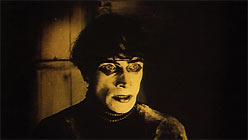Last Friday was the second night of Caligari, HurlyBurly Productions’ stage performance of the 1920s German Expressionist film The Cabinet of Dr. Caligari. Famous for its color-tinted frames, painted sets and severe camera angles, the silent film follows Francis, who with his best friend, Alan, finds himself at the local fair in Holstenwall. There, the main attraction is a somnambulist named Cesare who can predict the future. His master — Dr. Caligari — eggs on the audience members inside his tent, goading them to “Judge for yourselves,” which prompts Alan to jokingly ask: “How long do I have to live?” Apparently, he has until tomorrow.
When Alan dies, the finger points damningly at Cesare, and by extension, Dr. Caligari. Francis pursues an investigation of the two with the help of his fiancee, Jane who is later kidnapped by Caligari. But of course, she’s beautiful, and naturally, the frighteningly ugly somnambulist is touched by her beauty to the point of immobility, and soon thereafter dies.
Caligari is no typical carnie, and Francis discovers that this Doctor is actually the director of the local insane asylum. But — spoiler! — Francis actually relates the tale from the confines of the ward in which he, Jane, and Cesare are imprisoned. Caligari is a doctor in the asylum. Or is he? Ambiguity abounds.
A liberal adaptation, HurlyBurly Productions’ Caligari is more concerned with emotional presence than story. This is no venture for the plot-minded, as the production eschews rigid loyalty to the source material. Four years in the making, the play functions as an experimental exercise in recreating the film’s expressionist world of shadows and instability.



